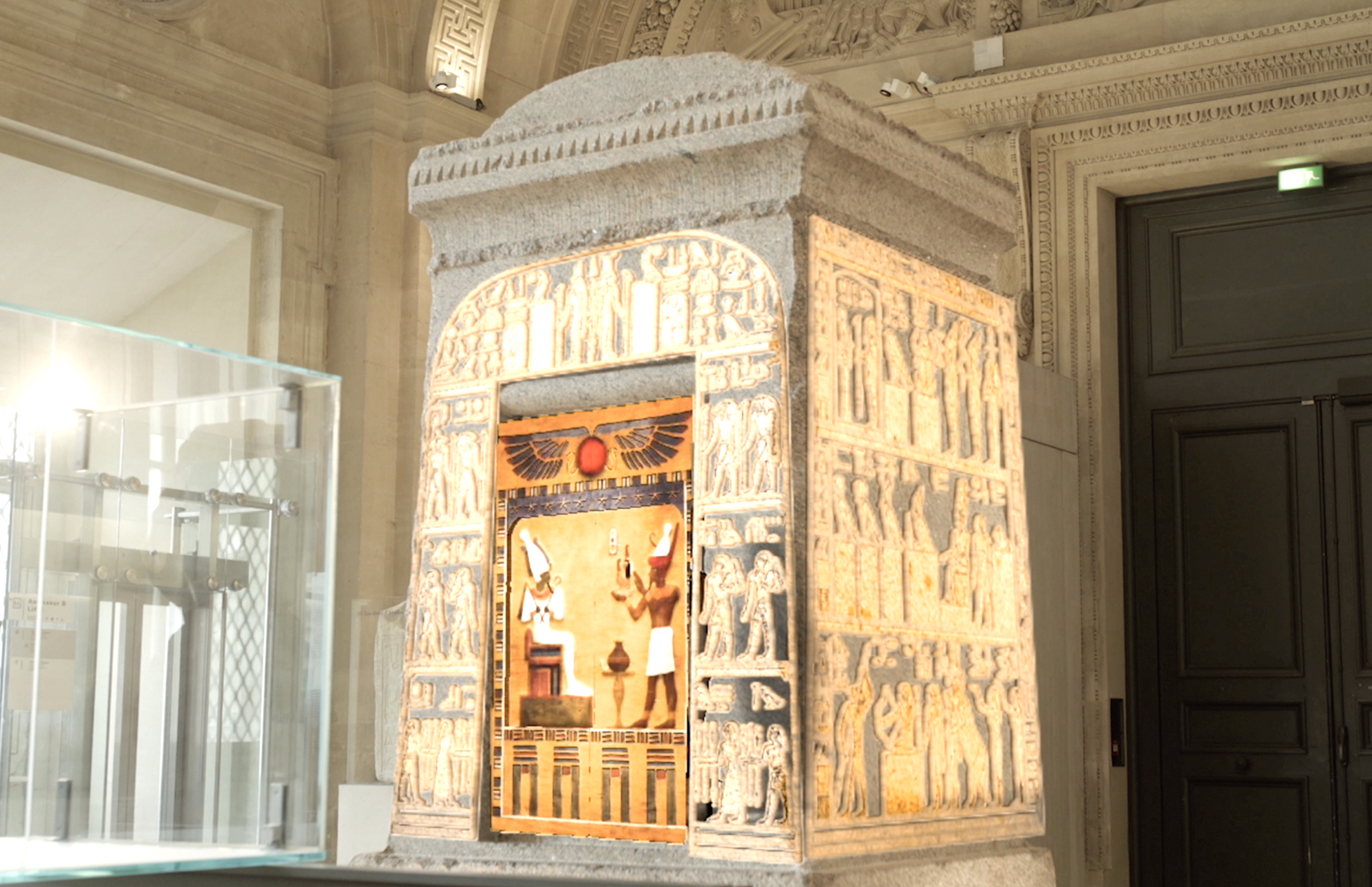
Egyptian ExperiencesL’Egypte augmentée au musée du Louvre
THE CHAMBER OF ANCESTORS
In the great temple of Amun-Ra at Karnak, the pharaoh Thutmose III (18th Dynasty, about 1480–1425 BC) had a chapel specially decorated to display his royal genealogy. Known as the Chamber of Ancestors, it features depictions of several dozen Egyptian kings in pattern-like rows covering the walls. Seated one behind the other on their thrones, each crowned with a nemes and a uraeus over the brow, their names are inscribed in cartouches. Though the list is not exhaustive, it names sixty-one sovereigns from nine of the seventeen royal dynasties preceding the reign of Thutmose III, who appears standing before them in a position of offering. Parts of the decoration carved in bas-relief, originally painted, were already missing in 1843, when French Egyptologist Emile Prisse d’Avennes had the remaining blocks dismantled. He then had them sent to France and made drawings of the missing motifs himself. This is how they have been displayed at the Louvre since 1922.

NAOS OF AMASIS
Under the 26th Dynasty, there was a temple dedicated to the god Osiris in the western Nile Delta. This temple was likely built by the pharaoh Amasis (570–526 BC), who had his name inscribed on the sanctuary’s pink granite naos. A naos is a small wooden or stone chapel present in each temple, housing the cult statue of the god to whom it was dedicated. The Naos of Amasis was found in the 19th century in the modern city of Kom el-Ahmar, or ‘the Red Mound’, and arrived here only after a long journey full of twists and turns, without the divine statue it once housed or the wooden doors that enclosed it in antiquity. Every day, according to ritual, priests would open these doors and bring offerings of food and drink, purified with smoke and libations, to the god, who was dressed in special attire. The naos is monolithic, meaning it was carved from a single block of granite, and it bears depictions on its outer walls of the many deities constituting the personal guard of the god Osiris.

OBELISK
The obelisk, which dates to the reign of the pharaoh Ramses II (19th Dynasty, about 1279–1213 BC), was set in front of the facade of the Temple of Luxor. It was gifted to France in November 1830 by Mehmet Ali, the wali, or viceroy, of Egypt. Following its removal, the obelisk was transported down the Nile, across the Mediterranean and up the Seine, arriving in Paris on 23 December 1833. There, it was erected at Place de la Concorde on 25 October 1836 before King Louis-Philippe, watching from a balcony of the Hôtel de la Marine, and a crowd of some 200,000 Parisians. The decision of where to install it was far from unanimous at the time, with ‘urbanists’ and ‘Egyptomaniacs’ (including Champollion) clashing on the subject: the former preferred Place de la Concorde, while the latter preferred the Cour Carrée. Alternatively, since both obelisks from the Temple of Luxor had been offered to France, the Egyptomaniacs suggested installation in front of a monument, such as the Panthéon, the Louvre Colonnade or the Church of the Madeleine. The population surveyed on the subject ultimately voiced a preference for Place de la Concorde.

ZODIAC
Upon its discovery, as with the Rosetta Stone’s during the same period, the Zodiac was immediately considered a key monument for understanding Pharaonic civilisation by the officers and scholars of Bonaparte’s expedition. Various astronomical phenomena are depicted on the ceiling of this chapel of the temple of the goddess Hathor at Dendera, among the most beautiful of Upper Egypt, including the twelve constellations of the zodiac, the five planets known at the time, and two eclipses – one solar and one lunar; it thus raised the great hope of being able to put a date to Egyptian civilisation for the first time. Dominique-Vivant Denon published a first drawing of it in 1802, sparking the most peremptory of astronomical hypotheses, and the Zodiac grew so famous that the pasha of Egypt authorised its removal in 1821. Louis XVIII agreed to purchase it in 1822 for the Cabinet of Medals. But the Church and and Pope Leo XII were concerned that this hoped-for date, should it prove to precede the Flood, could challenge biblical chronology. Jean-François Champollion, frequently seen in Rome copying the texts of the obelisks there, was called upon by the pope and reassured all those concerned by proposing the year 50 AD, based on archaeological rather than astronomical arguments. Today, the hieroglyphs of the temple’s dedicatory inscriptions, and the two eclipses depicted, have shown that the temple was founded in 54 BC, under the reign of the great Cleopatra.

Complementary documentation :
The facsimile of the Zodiac; Eric Aubourg, ‘La Date de Conception du Zodiaque du Temple d’Hathor à Dendera’ (in French only), Bulletin de l’Institut Français d’Archéologie Orientale, vol 95, 1995, pp. 1–10
Sylvie Cauville, Le Zodiaque d’Osiris, Éditions Peeters, 1997.